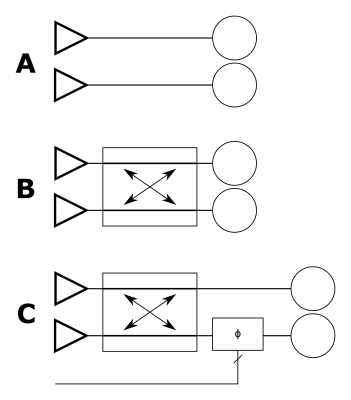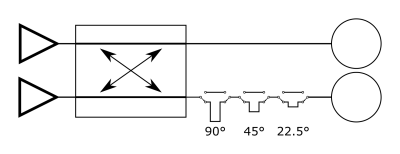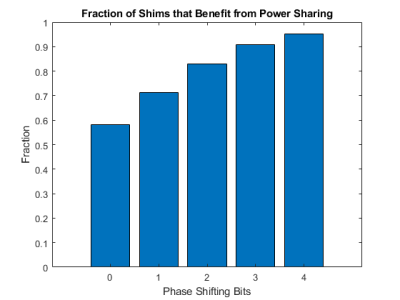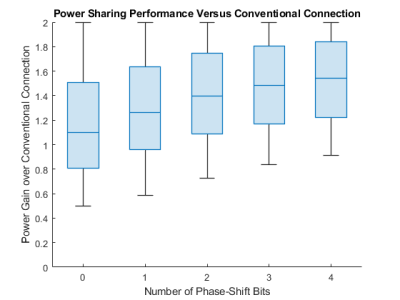2258
Improving the Flexibility of RF Power-Sharing Networks with High-Power Phase Shifters1Biomedical Engineering Department, School of Biomedical Engineering and Imaging Sciences, King's College London, London, United Kingdom, 2Centre for the Developing Brain, School of Biomedical Engineering and Imaging Sciences, King's College London, London, United Kingdom
Synopsis
A typical parallel transmit system has an equal number of RF power amplifiers individually connected to an equal number of coil elements. When performing B1+ shimming, the maximum B1+ available is limited by single channel amplifier performance. RF networks which allow for power to be shared between transmit channels have been proposed as a way to overcome this limitation, but fixed networks only offer performance gains over limited ranges of relative phases between channels. Adding a high-power phase shifter between a power-sharing network and coil element can combat this, even with only a few bits of resolution.
Introduction
In recent years there has been growing interest in parallel transmit (pTx) RF systems. At high field strengths, pTx can be used to create a more homogenous B1+ over the whole body or a specific region of interest1. The control over transmit fields provided by pTx can also allow one to better control the interaction of the transmit field with embedded or interventional devices2.The vast majority of pTx systems have a number of identical RF power amplifiers (RFPAs) connected to an equal number of transmit array elements. This is straightforward from a design perspective, but it means that if different amounts of power are required for each array element, the maximum transmit field (B1+) that can be produced is limited by the amplifier supplying the most power-hungry element while other amplifiers operate substantially below their maximum capability. This has the effect of both limiting the maximum achievable B1+ and increasing the expense of the parallel transmit system, as the amplifiers need to be more generously sized. Here we explore an approach to sharing power between channels. We look in detail at a 2-channel exemplar arrangement, but the approach can be generalized to multiple channels.
Theory and Methods
Fortunately, there exist networks of RF components that can be used to share power between parallel transmit channels3. Figure 1 shows an example. The fixed network in figure 1B is efficient when excitations either 0° or 180° apart are required, allowing power to be shared un-evenly (e.g., for two 1W amplifiers, 1.5W for coil 1 and 0.5W for coil 2). However, performance is very dependent on the relative phases required as shown in figure 3A. Performance rapidly drops as the relative phase deviates from the optimal angle for the network.To overcome this, we have examined inserting a variable phase shifter between the power sharing network and the transmit array elements (fig. 1C). This allows for the relative phase of the power sharing network’s outputs to remain closer to optimal as the relative coil phases are changed, improving the range over which the system performs well.
High-power phase shifters are typically digital devices. Figure 2 shows a 3-bit example. Because each bit requires two RF switches and an additional length of transmission line, it is desirable to use the fewest bits possible to minimize losses.
To explore performance, we calculated the maximum power that can be delivered as functions of the relative phase and power imbalance between channels. The basic power-sharing network in figure 1B and the phase-shifted power-sharing network in figure 1C and figure 2 were compared to the conventional configuration in figure 1A. We also simulated 100,000 random shims and explored what fraction of these would benefit from the proposed network with phase shifters of different bit depths.
Results
Figure 3 shows how adding even a phase shifter with just a few bits dramatically improves the range of angles over which a substantial improvement to flexibility is achieved. Adding 1-2 bits reduces the severity of a worst-case shim and using 3 bits allows for good performance at a wide range of phases and ratios.Figures 4 and 5 shows the results of the random shim simulations. Figure 4 shows that the majority of shims benefit from the basic (i.e. non-phase-shifted) power sharing networks, but adding a few bits of phase shifting substantially improves the fraction of shims that benefit. In figure 5 we see that in addition to improving the fraction of shims that benefit from power sharing, adding a phase shifter also decreases the performance penalty associated with a poorly-conditioned shim.
Conclusion
Power sharing networks have the potential to expand the capabilities of parallel transmit systems by increasing the maximum B1+ that a parallel transmit system can produce. Conventional power sharing networks, such as those based on 90° hybrid couplers, enable unequal division of RF power between array coil elements, but only perform well over a small range of relative phases. Adding high-power phase shifters between the power sharing network and the coil elements improves the flexibility of the power-sharing system, increasing the fraction of shims over which it provides an advantage over conventional parallel transmit systems. The phase shifter only needs a few bits to provide a dramatic improvement.Combining simple power-sharing networks with simple high-power phase shifters has the potential to increase the maximum B1+ available from existing pTx systems as well as to reduce the cost of new systems, which may be able to operate with lower-power amplifiers without sacrificing performance. This study focused on a 2-channel example, but the concepts are readily expanded to more channels and the gains in maximum power also scale with the number of channels.
This preliminary analysis has focused on B1+ shimming, but dynamically modulated complex pulses also stand to benefit from power sharing. Either an average phase shift could be chosen to maximize performance, or pulses could be designed to try to take advantage of the power-sharing network by considering the impact of relative phase in an optimization.
Acknowledgements
This work was supported by core funding from the Wellcome/EPSRC Centre for Medical Engineering [WT203148/Z/16/Z] and by the National Institute for Health Research (NIHR) Biomedical Research Centre based at Guy’s and St Thomas’ NHS Foundation Trust and King’s College London and/or the NIHR Clinical Research Facility. The views expressed are those of the author(s) and not necessarily those of the NHS, the NIHR or the Department of Health and Social Care.References
1Ibrahim, T S. Ultrahigh-field MRI whole-slice and localized RF field excitations using the same RF transmit array. IEEE Trans Med Imaging. 2006; 25(10):1341-1347.
2Godinez, F, Scott, G, Padormo, F, et al. Safe guidewire visualization using the modes of a PTx transmit array MR system. Magn Reson Med. 2020; 83:2343-2355.
3Ogier, S. E., Malik, S., and Hajnal, J Is it feasible to Make More Effective Use of Finite RF Power Resources in pTx Systems Using a Coupling Matrix? ISMRM 2021:1418.
Figures




